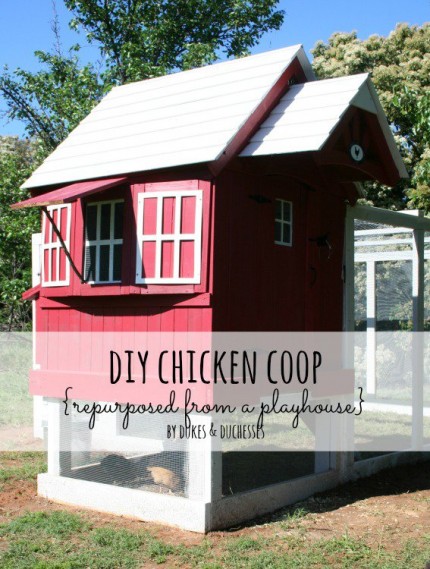
Raising chickens in your own backyard can be a rewarding and enjoyable experience, but it’s important to have a suitable and comfortable place for your birds to live. A well-designed chicken coop will protect your birds from the elements, keep predators out, and offer enough space for your birds to roost and nest comfortably. If you are looking for a DIY project that will not only provide a home for your chickens but also add some charm and beauty to your backyard, you may want to consider building a beautiful and functional DIY chicken coop.
Building your own chicken coop can be a challenging but fulfilling project, and with the right tools and materials, you can create a coop that meets your specific needs and design preferences. The blog Dukes & Duchesses has put together a great DIY post that shows you how to build a beautiful and functional chicken coop from start to finish. The post includes detailed instructions, materials lists, and plenty of photos to guide you through the process.
The coop featured in the post is made from wood and has a simple but stylish design that will blend in with any backyard. The roof is slanted to allow rain to run off, and there are plenty of windows to provide natural light. The coop has a spacious interior with plenty of room for your birds to roost and nest, and there is even a designated area for dust bathing. The coop is well ventilated to keep the air fresh, and there are multiple access doors for easy cleaning and egg collecting.
One of the best features of this DIY chicken coop is the addition of a covered run. The chickens can enjoy being outside without being exposed to predators, and you can let them out for a little exercise without having to worry about them running away. The run is also covered with a roof, providing shade and protection from the rain. The coop and run are built on sturdy legs, which makes it easier to clean and offers a convenient storage area underneath.
Building your own chicken coop can be a fun and satisfying project, and the end result will be a beautiful and functional home for your birds. You can customize the design and materials to fit your style and budget, and you will have the satisfaction of knowing that you created a cozy and safe place for your chickens. If you are looking for a DIY chicken coop project that is both beautiful and functional, be sure to check out the post on the blog Dukes & Duchesses.
In conclusion, raising chickens in your backyard can be a wonderful and rewarding experience, and having a well-designed chicken coop is essential for the health and comfort of your birds. Building a DIY chicken coop can be a challenging but fulfilling project, and with the right resources, you can create a beautiful and functional home for your chickens. Whether you are a seasoned DIYer or a beginner, you can find inspiration and guidance from the post on the blog Dukes & Duchesses.
See the post here: DIY Chicken Coop
Some things to consider when building your DIY Chicken Coop –
Raising chickens in your backyard can be a fun and rewarding experience, but it’s important to provide your birds with a safe and comfortable home. A well-designed chicken coop is essential for the health and well-being of your chickens, and it’s important to consider several key factors before you begin building your coop. Whether you are an experienced DIYer or just starting out, here are some important things you should consider for your DIY chicken coop.
Size: The size of your coop is one of the most important factors to consider. You want to make sure that your chickens have enough space to move around comfortably, roost, and lay eggs. Generally, you should aim to provide about 4 square feet of space per chicken, so be sure to calculate the number of birds you plan to house and plan your coop accordingly. Additionally, make sure to consider the height of the coop, as you want to allow enough room for your birds to stand up and move around comfortably.
Ventilation: Good ventilation is crucial for the health and well-being of your chickens, and it’s important to plan for adequate ventilation in your coop. This will help to keep the air fresh and prevent the buildup of moisture, which can lead to mold and other health problems. You can add windows and vents to your coop to improve air flow, or you can consider building the coop with a slanted roof to allow for better ventilation.
Protection from the Elements: Your chickens need to be protected from the elements, including wind, rain, and extreme temperatures. A coop with a solid roof, sturdy walls, and a secure door will provide protection from the weather, and you can add insulation or other features to improve the coop’s resistance to the elements. Additionally, it’s important to make sure that the coop is elevated off the ground to prevent moisture buildup and to make cleaning easier.
Security: Keeping your chickens safe from predators is one of the most important things to consider when building your coop. A secure coop with sturdy walls and a secure door will keep predators out, and you can add extra security features, such as a wire mesh roof, to increase the coop’s protection. Additionally, it’s important to keep the coop away from potential sources of danger, such as busy roads or areas with high predator populations.
Accessibility: You want to make sure that your coop is easy to access for cleaning and egg collecting, so consider the location and design of the doors and windows. You may want to consider adding multiple access points, such as a door for humans and a small door for chickens, to make it easier to clean and care for your birds.
Lighting: Chickens need natural light to regulate their circadian rhythm and promote good health, so it’s important to plan for adequate lighting in your coop. You can add windows to the coop to allow natural light in, or you can consider adding artificial lighting if your coop is located in a place with limited natural light.
Building Materials: The materials you use to build your coop will impact its durability, resistance to the elements, and overall appearance. Consider the climate and weather conditions in your area, and choose materials that are weather-resistant and durable. For example, you may want to use rot-resistant wood, or you may want to consider using metal or vinyl siding for a coop that is low-maintenance and easy to clean.



